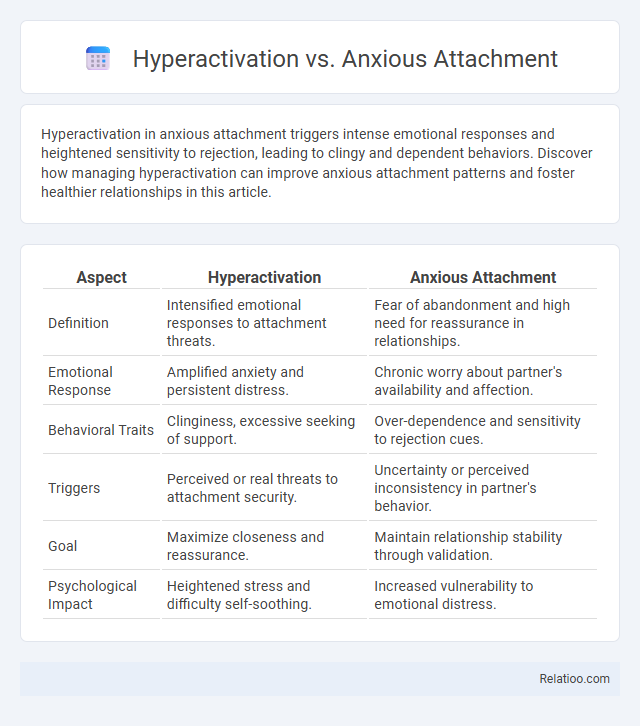Hyperactivation in anxious attachment triggers intense emotional responses and heightened sensitivity to rejection, leading to clingy and dependent behaviors. Discover how managing hyperactivation can improve anxious attachment patterns and foster healthier relationships in this article.
Table of Comparison
| Aspect | Hyperactivation | Anxious Attachment |
|---|---|---|
| Definition | Intensified emotional responses to attachment threats. | Fear of abandonment and high need for reassurance in relationships. |
| Emotional Response | Amplified anxiety and persistent distress. | Chronic worry about partner's availability and affection. |
| Behavioral Traits | Clinginess, excessive seeking of support. | Over-dependence and sensitivity to rejection cues. |
| Triggers | Perceived or real threats to attachment security. | Uncertainty or perceived inconsistency in partner's behavior. |
| Goal | Maximize closeness and reassurance. | Maintain relationship stability through validation. |
| Psychological Impact | Heightened stress and difficulty self-soothing. | Increased vulnerability to emotional distress. |
Understanding Attachment Styles: An Overview
Understanding attachment styles is essential for recognizing how emotional bonds influence your relationships and personal development. Hyperactivation refers to an intensified emotional response often seen in anxious attachment, where individuals experience heightened sensitivity to perceived rejection or abandonment. Differentiating hyperactivation from anxious attachment helps clarify how certain coping mechanisms shape interpersonal dynamics and emotional regulation.
Defining Hyperactivation in Attachment Theory
Hyperactivation in attachment theory refers to an intensified emotional response aimed at securing closeness and reassurance from attachment figures, often seen in individuals with anxious attachment styles. This process amplifies distress signals, such as heightened anxiety and persistent seeking of validation, to prevent perceived abandonment or rejection. Understanding hyperactivation is crucial for distinguishing anxious attachment patterns, characterized by excessive needs and emotional dependence, from other attachment dynamics.
What is Anxious Attachment? Key Features
Anxious attachment is characterized by a deep fear of abandonment and a constant need for reassurance in relationships, often leading to emotional hyperactivation. Key features include heightened sensitivity to rejection, persistent worry about partner's availability, and difficulty regulating emotions under stress. Understanding how your anxious attachment triggers hyperactivation can help you develop healthier coping strategies for relationship challenges.
The Psychological Roots of Hyperactivation Responses
Hyperactivation responses stem from early attachment insecurities where inconsistent caregiver availability leads to heightened emotional sensitivity and anxiety. These psychological roots create a persistent state of alertness, as Your brain anticipates rejection or abandonment, intensifying anxious attachment behaviors. Understanding these mechanisms helps differentiate hyperactivation from other attachment responses and informs therapeutic interventions.
Hyperactivation vs. Anxious Attachment: Core Differences
Hyperactivation is a behavioral response characterized by heightened emotional intensity and persistent efforts to seek closeness, often linked to anxious attachment but distinct in its activation patterns. Anxious attachment involves a deep-seated fear of abandonment and a need for reassurance, which fuels hyperactivation but also includes underlying insecurities and dependency tendencies. Understanding the core differences between hyperactivation and anxious attachment helps you recognize the specific dynamics influencing your emotional regulation and relationship patterns.
Emotional Regulation in Hyperactivation and Anxious Attachment
Hyperactivation in emotional regulation involves an intense and overwhelming response to perceived threats, often leading to heightened anxiety and difficulty calming down. Anxious attachment is characterized by a persistent fear of abandonment and excessive dependence on others for emotional support, which exacerbates hyperactive emotional responses. Both hyperactivation and anxious attachment disrupt effective emotional regulation by amplifying sensitivity to emotional stimuli and impairing the ability to manage distress.
Behavioral Patterns in Relationships
Hyperactivation in relationships manifests as heightened emotional intensity, persistent need for closeness, and increased sensitivity to rejection, often leading to clingy or demanding behaviors. Individuals with anxious attachment exhibit similar behaviors, characterized by fear of abandonment, excessive reassurance-seeking, and difficulty trusting partners, resulting in emotional volatility and dependency. Both hyperactivation and anxious attachment contribute to patterns of insecurity and interpersonal conflict, highlighting the importance of developing secure attachment strategies to foster healthier relational dynamics.
Impact on Communication and Conflict Resolution
Hyperactivation in anxious attachment triggers heightened emotional responses and persistent worry, often leading to misinterpretation and overreaction in communication, which complicates conflict resolution by escalating tensions. Individuals with anxious attachment tend to seek constant reassurance, making conflict resolution challenging due to fears of abandonment and perceived rejection. Effective communication strategies must address the underlying attachment dynamics to reduce emotional intensity and foster constructive dialogue.
Healing Strategies for Insecure Attachment Styles
Healing strategies for insecure attachment styles focus on establishing emotional regulation techniques, such as mindfulness and grounding exercises, to reduce hyperactivation symptoms like intense anxiety and emotional reactivity. Therapeutic approaches including cognitive-behavioral therapy (CBT) and attachment-based therapy emphasize building secure relational patterns by addressing fear of abandonment and enhancing self-soothing skills. Consistent, empathetic interpersonal experiences foster resilience and gradual reorganization of anxious attachment patterns toward secure attachment.
Promoting Secure Attachment: Pathways to Growth
Hyperactivation and anxious attachment both involve heightened sensitivity to emotional cues, often leading to intense fear of abandonment and difficulty trusting others. Promoting secure attachment requires fostering consistent, responsive caregiving that helps you regulate emotions effectively and build healthy relational patterns. Developing emotional awareness and practicing adaptive coping strategies enable individuals to transition from hyperactivation toward security and resilience in relationships.

Infographic: Hyperactivation vs Anxious Attachment
 relatioo.com
relatioo.com